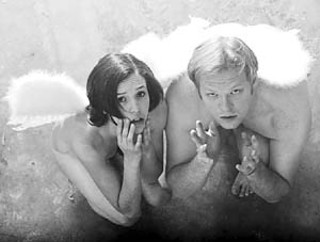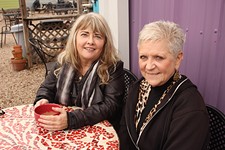A Revolution in Acting
The SITI Company's J. Ed Araiza transforms the way Austin actors view their art
By Katherine Catmull, Fri., April 9, 2004

This isn't like watching a normal acting class. This is like watching a school of fish. Invisible eddies and currents push some actors this way, some that. Others clump together, nearly still, only their heads moving in a silent ballet of twists and turns as the rest swirl around them. A tall, yellow-haired boy pauses just behind a smaller girl, his chin poised above her head. A short, dark girl darts in and out among the larger group.
Their teacher is offering gnomic suggestions and observations, clearly meaningful to the students. "Don't make anything happen, but let anything happen," he says. Or, "Go through the doors between each other." Sometimes the actors seem almost telepathic. It's curiously thrilling, this fluid, unpredictable dance whose pattern you can't quite catch – like watching fish, yes, or Brownian motion or your own thoughts. Or a weirdly purposeful, silent cocktail party.
Recently, a crop of unusually promising young actors has appeared on the Austin theatre scene, contributing vivid performances to shows as diverse as The Road to Wigan Pier, The Cry Pitch Carrolls, American Arcana, Quake, and The Kentucky Cycle. These actors – Bradley Carlin, Brent Werzner, Elizabeth Wakehouse, Jeffery Mills, and Andrea Skola, among others – project a quirky onstage confidence and self-possession, a freshness and flexibility that relishes the unexpected. They also share a set of more traditional theatrical virtues: clarity of intent, physical precision, vocal strength.
What's the breeding ground for these notable young actors? St. Edward's University, it turns out, where all have worked extensively with visiting instructor J. Ed Araiza of the SITI Company.
The New York-based SITI – shorthand for Saratoga International Theatre Institute – has earned an international reputation for its performances grounded in the specialized training of acclaimed directors Anne Bogart and Tadashi Suzuki. Bogart's is the school-of-fish-producing system called Viewpoints – a vocabulary for improvisational movement-based ensemble work. Suzuki training, in sharp contrast, is a fiercely rigorous approach to physical acting. These two schools of training, most particularly the Viewpoints, are transforming American acting technique in the most revolutionary fashion since the Method was introduced more than 50 years ago.
And Austin is getting an early taste of this revolution because Melba Martinez, head of the St. Edward's theatre department, has established a relationship with SITI and brought Araiza and his innovative work regularly to this city for the past two years.
Araiza's first project at St. Ed's was The Medea Stories, his own galvanizing adaptation of Euripedes' tragedy for a world accustomed to Court TV informed by SITI's intensive actor training plus student dramaturgy. Six months later, he used a similar process to create c/o The Grove, a Texas take on Chekhov's The Cherry Orchard. (Put away that rope, hoss – Araiza is a San Antonio native, so he's allowed to have a Texas take.)
Although the projects were very different, both featured lots of what Araiza – a slender, animated man who triples as actor, director, and playwright – calls "that juicy theatrical stuff": singing/dancing choruses, pop music, and urgent, precisely choreographed mass movements that can be electrifying to watch.
This spring, Araiza is back to create, with the students' help, an entirely original piece called The House Project. But while this play is the focus and framework of their work, at the core is the training.
It's hard to overplay how radically significant this new system feels, given that mainstream theatre education has been mired in 1947 since, well, 1947, the year Lee Strasberg founded his Method-based Actor's Studio. Brando and Dean trained in the Method, as have many brilliant actors since, but the system is better suited to film than stage work. Its emphasis on summoning feeling can generate strong, spontaneous emotional response – which may be great for short cinematic bursts but can be tough to reproduce night after night on stage. Then there's the emphasis above all on what the actor feels; emotions alone, no matter how genuine, "read" better in a film close-up than from 30 rows back in a theatre. Plus, the Method doesn't provide actors with objective training tools – no equivalent to a dancer's work at the barre or a musician's practice scales.
The SITI combination of Viewpoints and Suzuki changes all that.
Originally developed by choreographer Mary Overlie in the late Seventies for use in modern dance, the Viewpoints were tweaked and expanded by Bogart to give actors nine "viewpoints," or ways of thinking about time and space concepts in developing a scene, among them tempo, duration, kinesthetic response, shape, gesture, and spatial relationship. Araiza says, "Time and space ... are the tools that all artists deal with. And the Viewpoints in particular give you the improvisational ability to recognize time and space and then ... be able to manipulate them."
To help explain the usefulness of these concepts in theatre, Araiza observes that "the space between two bodies is an extremely powerful narrative tool. Extremely. You see two people close on stage; you see two people, five seconds later, at opposite sides of each other across the stage. That's a story. And that's nothing but the space between them."
The effect on actors is powerful. The House Project guest artist Jenny Larson says, "I love the energy and connection you can build with your ensemble. ... You deal with spatial relationship and rhythms, and you understand what will be compelling to the audience and what isn't."
Brad Carlin, another guest artist and a 2002 St. Ed's graduate who has worked with Araiza on all three shows, comments on "how eerily [the Viewpoints training] bleeds into everyday life. ... All of a sudden, a large crowd of people at a concert or the mall becomes a large Viewpoints exercise."
Freshman Lanella Zotter, a recent Crockett High graduate, says, "Although there is structure, nothing is choreographed, so 'accidents' can happen that may inspire ingenious blocking or business."
The growing popularity of Viewpoints training is "kind of scary for us as members of the SITI company," Araiza says, "because it's fun, and it seems deceptively easy. People take a weekend workshop and they learn the names of the Viewpoints ... and they think they've got it. ... Nobody would take a class with Bill T. Jones or Twyla Tharp and after that weekend go, 'I know Twyla Tharp's technique.'"
If watching Viewpoints is like peering into a dreamy aquarium, Suzuki training, developed in Japan by Tadashi Suzuki, comes off like a slightly surreal military drill. (Araiza winces at the word "military": "I just think it's disciplined.") Students line up with intense, fixed eye focus, stomping, sliding, and squatting in unison, sometimes simultaneously reciting text in harsh, driving choruses.
Araiza calls out help and adjustments. "Tension is just misplaced energy – send it into your center so you can speak," he urges one girl. Surprisingly, given its physicality, Araiza says, Suzuki work is particularly suited to the heightened texts of great world literature; it is "comprehensive, in that it deals with the whole body and includes very rigorous vocal work – not relaxed vocal work. It provides a crucible that enables you in class to test yourself out against extreme situations, not unlike what you're going to encounter onstage."
Junior Valerie Redd agrees, calling Suzuki training "incredibly challenging physically, mentally, and emotionally. ... It's about controlling your energy and using it in the most arresting and efficient way."
Araiza believes that one of the strengths of the SITI Company is the dissimilarity of these two techniques. He says that Bogart likes to contrast the "vertical energy" of Suzuki training with the "horizontal energy" of the Viewpoints. "So when you put the two together, that gives you the ability to do both," he explains: "that ability to focus, as the Greeks did, between you and God; and the ability to concentrate, to focus between you and the audience."
Araiza also involves his students in researching and, to some extent, even writing the pieces he creates at St. Edward's. Students bring in research, dreams, pieces of writing – "a lot of the text [for The House Project] is their words filtered through my brain."
While watching the students at a cast party for c/o The Grove, Araiza says, "I just said to Melba, 'If you ever want me to come back, I want to do a show that's about them.'" The play treats "something that I think is very prevalent in everyone's lives, particularly at that age – looking back at myself, absolutely myself at that age – dreams. What are your dreams?"
Night dreams? Or dreams for the future? Araiza smiles. "What's the difference? Without saying too much, that's one of the questions this show is asking." Although The House Project is not an adaptation, it borrows elements from Milton's Paradise Lost as a framework for the lives of its young characters.
Of his rehearsal process, Araiza observes, "You'll see me challenging them. And they'll be frustrated sometimes. And that's OK. Part of the training is when you're frustrated and don't know what to do – that's the chance where art can really happen. Do you keep going? Or do you go, 'I'm out'? My job is to give them the confidence to not back down when they get to that point."
That's worked for Zotter, who says, "The training is challenging, and you feel sometimes that you have been pushed to your limit. ... But that is when you realize that you're capable of so much more than you'd have ever thought possible. That's the real reward."
Carlin calls the training "the single most important influence on my work thus far. And I plan on accessing it, albeit in different degrees, in every project I approach."
This summer, Araiza will rejoin the SITI Company to perform the European premiere of Charles Mee's bobrauschenbergamerica at the Bonn Biennale. But he will return to St. Edward's in June to direct One Flew Over the Cuckoo's Nest – an unexpected choice, one certain to be entirely unlike The House Project. Sophomore Joseph Parks, who worked with Araiza on c/o The Grove, says that show "was very different than the process of this show. But then, I do not think that anything J. Ed does would be the same. Everything he does is totally original and new. ... I plan to work with J. Ed as long as I possibly can." ![]()
The House Project runs April 15-25 at the Mary Moody Northen Theatre, 3001 S. Congress. For more information, call 448-8484.










